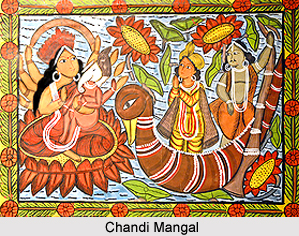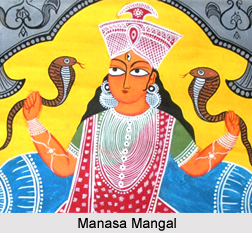 Shivayan poems before post fifteenth century had undergone a major development in portrayal of Lord Shiva. Siva of Bengali folk-lore is a rustic created by rustics in their own image. It has no cosmic and philosophic qualities the classical prototype. Here it is shown that Lord Shiva is tilling the soil instead of dancing the cosmic dance of creation and destruction. He is no longer a thing in it itself, the abstract and abiding principle in a concrete world. He is an old forest God keeping low company and running after low women. From the mythological god who swallowed poison to save the universe he has now deteriorated into a drug-addict. He does not retain the qualities of Lord Buddha with whom he had been identified partially. The Siva of Bengali folk-songs is a drifter who would beg rather than work and possess no sense of social responsibility.
Shivayan poems before post fifteenth century had undergone a major development in portrayal of Lord Shiva. Siva of Bengali folk-lore is a rustic created by rustics in their own image. It has no cosmic and philosophic qualities the classical prototype. Here it is shown that Lord Shiva is tilling the soil instead of dancing the cosmic dance of creation and destruction. He is no longer a thing in it itself, the abstract and abiding principle in a concrete world. He is an old forest God keeping low company and running after low women. From the mythological god who swallowed poison to save the universe he has now deteriorated into a drug-addict. He does not retain the qualities of Lord Buddha with whom he had been identified partially. The Siva of Bengali folk-songs is a drifter who would beg rather than work and possess no sense of social responsibility.
However with the puranic renaissance of the fifteenth century and after regaining some of his finer qualities and old classical grandeur the poets wrote well about him. These poets were men of some culture and the people for whom they wrote belonged to the middle class. Bengali language and literature had undergone a change post fifteenth century due to contact with the classical language and literature. The rustic deities become refined by gaining access to the upper class society. Therefore it is believed that Siva of the Sivayan poems is the head of a middle-class family rather than a ploughman. He performs the duties of a husband and a father perfectly. One of his most important functions in the Sivayan poems is to provide innocent fun as an old husband of a young wife. This had a particular significance in the social custom of the age.
 The middle-class influence is revealed in the prominence which Siva`s wife Durga gets in these poems. She steals quite often the main interest. She represents the ideal wife and mother and is a very popular goddess in Bengal.
The middle-class influence is revealed in the prominence which Siva`s wife Durga gets in these poems. She steals quite often the main interest. She represents the ideal wife and mother and is a very popular goddess in Bengal.
The Siva songs were oral till they were put into writing. Many of the topics like Siva as a ploughman, his marriage and his domestic life, are found in the Sunya-puran, in some parts of the Ramayana, Manasa-mangals and Chandi-mangals of the fifteenth and sixteenth centuries. Such topics have also been mentioned in the Kalika-Puran by Narayan Dev. The earliest Sivayan poems were written by Kavichandra Chakroborty and Dwija Ratidev in the seventeenth century. Dwija Ratidev`s work is known as Mrigalubdha. Ramkrishna Roy was also a Shivayan poet who wrote in the seventeenth century. Some more poems were written in the eighteenth century when Rameswar Bhattacharya whish is the best Sivayan poem in Bengali language. His poem is also called Siva samkirttan. It is homely and suit to the simple joys and sorrows of life.
Shivayan poems composed by Ramkrishna Roy narrate the story of Lord Shiva based on the Puranas. His poem has no vulgarity. His work is a mixture of Puranic and Laukik aspects of Lord Shiva. He was able to bring the celestial Shiva down to earth with his poetic skill. He was a representative poet of Shivayan stream of Mangal kavya. It is believed that al together twenty five poets wrote Shivayan poems.



















